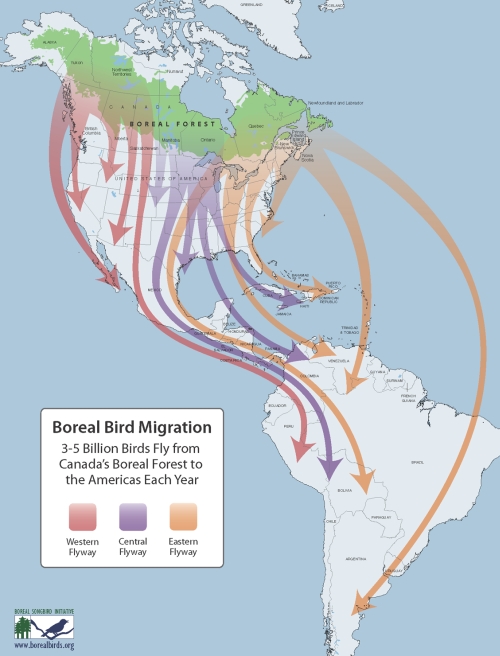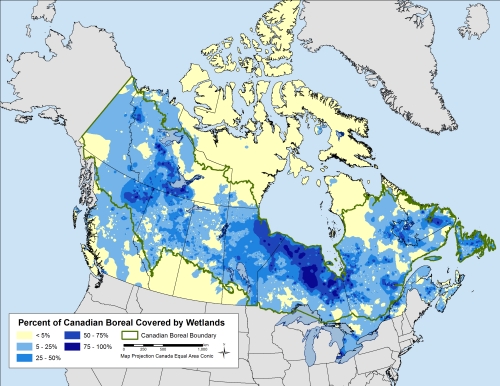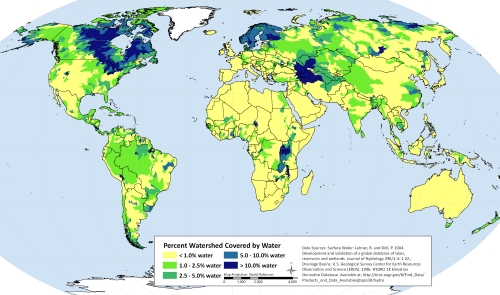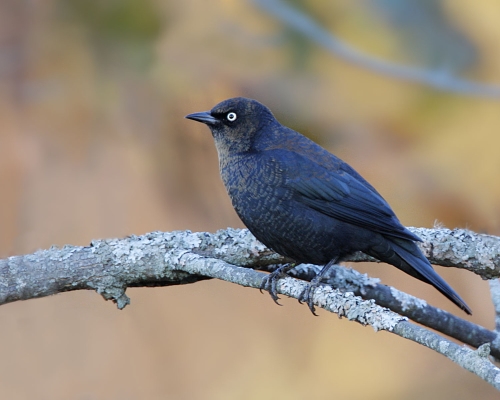The boreal forest of Canada is a critical stronghold of our planet’s bird life, supporting large portions of the global population of many species. Billions of birds migrate to and from the boreal region and reproduce in the short boreal summers, largely because of the region’s abundant wetlands and undammed waterways.
October 26, 2011 (Ottawa) – As billions of birds near the end of their annual fall migration from Canada, international experts are calling for increased protection of Canada’s “bird nursery of the north”: the water-rich boreal forest which contains the breeding and nesting grounds for billions of migratory birds and whose waterways and wetlands are under increasing pressure from the double threat of industrial expansion and climate change.
In a report released today entitled Birds at Risk: The Importance of Canada’s Boreal Wetlands and Waterways, a coalition of conservation organizations have called upon Canadian governments to seize on the many opportunities to save intact boreal landscapes—the largest source of global freshwater—while there’s still time.
“Just as we depend on the natural resources of the boreal, so do billions of birds who nest, breed and stop over there,” said Ted Cheskey, Nature Canada’s manager of bird conservation and a co-author of the report. “These vital waterways and wetlands are under increasing threats posed by industry such as tar sands, mining, logging and hydropower. This is, of course, compounded by the effects of climate change.”
“Canada’s boreal is the largest intact forest left on earth,” said Susan Casey-Lefkowitz, international program director at the Natural Resources Defense Council. “Yet only a fraction of this landscape is protected, far less than is scientifically recognized as necessary to sustain the ecosystem over time. Thankfully, we still have the potential to make a unique contribution to conserving international migratory birds through preservation of the boreal. Governments should act quickly, using the best science available, to create a healthy future for the boreal and the migratory birds who call it home.”
The report was issued by Nature Canada, Nature Quebec, the Boreal Songbird Initiative, and the Natural Resources Defense Council and focuses on three boreal areas that are critical for birds:
- The Hudson and James Bay Lowlands, where hydroelectric projects in the Hudson and James Bay Lowlands have flooded a huge swath of boreal forest, removing prime breeding habitat for as many as 10 million birds, including the Surf Scoter.
- The Peace-Athabasca Delta, where a dam and tar sands operations are reducing flows, and threatening water quality.
- The Lake Superior Watershed, where logging is reducing the diversity of plant and animal species and threatens food supplies and aquatic habitat.
The report also notes that the boreal waterways, peatlands and wetlands are important to some of the most threatened bird species, including the Rusty Blackbird which breeds across the boreal and always nests near water.
The Rusty Blackbird has experienced a more than 90 percent population decline since the 1960s and is listed under Canada’s Species at Risk Act as a species of “Special Concern.”
“For some very vulnerable species of boreal birds,” said Jeff Wells, Boreal Songbird Initiative’s Science and Policy Director, “Canada’s boreal forest is their last haven and their best hope for survival. We can’t take it for granted that the boreal will always remain an intact landscape with abundant resources. Action should be taken now to safeguard the boreal for our benefit and the benefit of our shared global resources.”
“As many as five billion birds flood south from the Canadian boreal to wintering grounds in the US, Mexico, and beyond. Canadians have an international responsibility to protect these breeding grounds as reflected in Canadian laws and international agreements,” Cheskey said. “Protecting the boreal from the threats of development also protects indigenous communities across the boreal, where many people still live very close to the land. We strongly urge all governments in Canada to work with First Nations and others on a secure future for wildlife and birds by protecting at least 50% of the boreal forest.”
For more information, contact:
Ted Cheskey, Manager of Bird Conservation
Nature Canada
Tel: (613) 562-3447 ext. 227
Cell: (613) 620-5324
tcheskey@naturecanada.ca
Blog: www.naturecanadablog.blogspot.com
Susan Casey-Lefkowitz, Director, International Program
Natural Resources Defense Council
Tel: (202) 289-2366
Cell: (646) 287-6225
email: sclefkowitz@nrdc.org
Blog: http://switchboard.nrdc.org/blogs/sclefkowitz/
Jeff Wells, Ph.D., Science and Policy Director
Boreal Songbird Initiative
Tel: (207) 458-8492
jeffwells@borealbirds.org
Blog: http://www.borealbirds.org/blog/
Backgrounder: Boreal by the numbers
- Canada’s boreal forest represents 25% of the world’s remaining intact forest.
- The boreal contains the world’s highest concentrations of large wetlands, lakes, and undammed rivers. There are more than 800,000 square kilometers of surface fresh water within its borders.
- Over 300 species breed in the boreal.
- Of these, 40 land birds and several duck species are facing declines. Habitat loss is one likely cause.
- 80% of North American waterfowl, 63% of finches, and 53% of warblers breed in Canada’s boreal forest.
- For at least 96 species, over half of their entire breeding population occurs in the boreal.
- Many boreal bird species have registered serious declines in recent years. Rusty Blackbirds have declined by 90%, Boreal Chickadees and Evening Grosbeaks by more than 70%, Olive-sided Flycatchers, Bay-breasted and Canada Warblers by over 50% as have the boreal-breeding ducks Surf Scoters and Scaup.
- Boreal birds are serious economic drivers. Boreal birds conduct over 5 billion dollars worth of ecological services by pollinating plants and controlling insect pests.
- 60 million people spend time in North America watching migratory birds and 3.2 million people hunt ducks and geese every year spending tens of billions of dollars annually on travel, lodging and gear.













Comments on this entry are closed.
You have no comments on this post, which is an indication of the priority of my forest and the boreal north of me. That is because it requires an effort, and that effort is mainly from your country. Everytime someone drives to a birding site in NA, the carbon imprint is enormous from the car construction, to the fuel it uses, to the road it travels on, all petroleum, and energy waste. You drive to parks to watch wildlife, because you have no free land like the Boreal and my forest left. You’re in a cycle which no one calls a halt to. Again because it requires the courage of the small individual citizen. It’s not going to come from your government, because they’re in the pocket of the oil companies, and big business that does not want to change. Boom & Gary of the Vermilon River, Canada.
@Gary unfortunately the entire world is still on the oil and gas bandwagon. This huge boom in Tar Sands Oil came because oil companies like Suncor (a Canadian oil company) saw the price of oil going up and thought it would be worth much more than it currently is today to develop. Of course the U.S. sees a huge potential for non-Arab oil and wants to take advantage of this opportunity.
People all over North America have to stand up and demand alternative energy sources be developed to ween the world off oil. It is a huge undertaking but at least we are talking about it.
The wanton destruction of the Athabasca is devastating to our environment and we must try to stop it now.
There is a wonderful article at National Geographic on the history of how we got to where we are now. I urge everyone to read it!
Right NOW it is important to send letters to President Obama to let him know we are opposed to the tar Sands pipeline under consideration by going to TarsSandsAction.org and simply filling out the form.
Here are more links to important information on how important the Boral Forest is to the world:
http://www.borealbirds.org/birdstarsands.shtml and you can get the fact sheet on the Tar Sands here http://www.borealbirds.org/resources/factsheet-ibcc-tarsands.pdf.
I will try to write another post on this and drive some traffic to the letter writing site and spread the information by Twitter and Facebook.
Come on Larry. Exxon/Mobile, Chevron, and Exxon again through its affliate Cdn Imperial are just a few of the companies besides Norway, China Japan and some others that are there. And that’s not counting the smaller companies that God knows who owns their stock. Sixty-six percent of the oil is exported and 99 percent goes to the US. Cdn demand for oil is stable ;US demand is growing, and that for the fuel cuts( gas diesel and jet fuel) of the barrel. Not only is land contaminated in the sands, but water as well. The oil is dirty because it has 2-4 times the green house gases of conventional oil, and when, you add in the refining process it’s 10-45 % more. It’s loaded with sulphur. After refining oil very little of the gasoline has an octane high enough for use: it has to be cracked using more energy and water. That’s why the petroleum engine is not suitable today. You should have watched David Susuki on CBC TV, you would hve seen US politicians and retired admirals liking the oil sands, ones that you would recognize. You would have see Hilary Clinton saying we might as well use it. You would have seen everyday US citizens standing besides gas guzzling trucks, saying it’s OK. It isn’t just birds either , its fish with tumors, humans with rare cancers, elk herds under stress, because the opening of the area with roads has made it easier for the wolf to hunt them. I showed a bit of tundra, muskeg or taiga on my blog to show how difficult it is to reproduce. Because now the companies reforestration projects are under question. The steam extraction method is risky because it may breach the clay shield that separates the Athabasca acquifer. It flows into the Artic and if contaminated will carry oil into the artic. Now a word about oil companiers. They have no nationality; they hire the brightest and the smartest generalists and create their own culture, so governments don’t stand a chance against them. That’s why the fight is at the citizen level. And yes Larry it’s nice to have you on board, but be aware how really dangerous the sands are. The answer is to stop using oil so that our needs can be met from conventional wells and then we can turn to alternative systems. Boom & Gary of the Vermilon River, Canada.
@Gary I’m on your side. The US’s oil consumption is way out of hand. I currently drive a Prius and would love to drive an all electric car and never visit a gas station again. Unfortunately too many Americans indulge themselves in excesses of everything including gas. I thought people would wise up when the price of gasoline got over $4 a gallon but I see lots of folks screaming around at high speed in their gas guzzling trucks and SUVs.
And have you seen the way the coal companies blow the tops off mountains to get the coal?